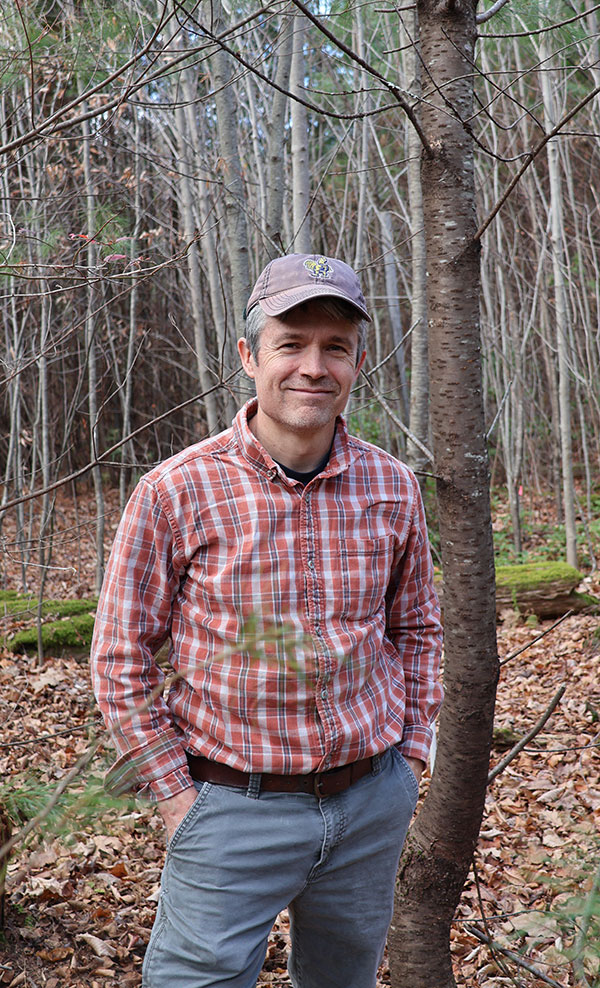
White-tailed deer are one of New England’s most iconic creatures and a common sight in human-dominated environments, including suburban backyards and gardens. But what effect are deer—and their cousins, moose—having on the region’s forests?
Highstead Senior Ecologist Ed Faison has been studying the impacts of deer and moose on New England’s forests, including deer browsing at Highstead, for nearly two decades. He uses large, fenced plots called exclosures to exclude these ungulates and prevent browsing, and then compares plant growth within the exclosures to the same in an open, or “control” plot. And while his data suggest that both deer and moose can have a big impact, they are not a significant limiting factor over the long-term when it comes to forest regeneration growing in patch cut timber harvests.
“The message people often hear is deer and moose have caused a regeneration failure,” he says. “But when the canopy opens up, these animals can’t control the forest. Forests here in New England regenerate in gaps, and what we see is this forest is perfectly capable of regenerating— even when it is being heavily browsed—if you open up the canopy.”
Faison’s herbivore research was recently published in the journal Forest Ecology and Management.
Highstead’s two deer exclosures occur under a maturing forest without canopy openings. They were surveyed in 2007, 2013, 2018, and 2023. Faison’s research suggests that in addition to deer, light is limiting regeneration and plant abundance and diversity. For example, within the exclosure, almost no light reaches the forest floor in one of the plots due to the dense shrub layer, which is safe from deer browse. In that plot there is no tree regeneration and a low diversity of herbaceous plants.

“The herb (lowest) layer is more diverse outside the plot where the deer are eating, which is counterintuitive,” he says. “But if you don’t let deer browse for 26 years, you’re going to get an incredibly dense shrub layer which is going to have a huge impact on what’s growing underneath it.”
Deer browse is species-specific. Faison says there is more Japanese barberry and stiltgrass—invasive species that deer dislike—outside the exclosure where populations of spicebush and other natives that deer prefer are suppressed. Interestingly, burning bush—another prominent invasive species that deer favor—is far more abundant inside the enclosure.
Recently, Faison divided this large, one-acre deer exclosure into two, 30-by-30-meter plots with a 60-meter gap in between. It’s a unique opportunity to study what happens when deer return to a forest from which they have been excluded for a quarter century.
This forest is perfectly capable of regenerating— even when it is being heavily browsed—if you open up the canopy.
Faison is also studying the impacts of herbivore browsing at several other sites, including the Quabbin and Ware Reservoir Forests and Harvard Forest in Massachusetts, and Great Mountain Forest, a 6,000-acre parcel located in Norfolk, Conn. In the winter of 2010, Great Mountain conducted a patch harvest of a white pine stand. That spring, he built three experimental treatments in the harvested stand: a full exclosure that excludes both deer and moose; a partial exclosure with a two-foot gap at the bottom that provides access to deer, but not moose; and an open or control plot where both deer and moose can freely browse. Inside each treatment, he designated a 16-by-16-meter plot to eliminate any impacts of the fence on herbivore browse from his study. Every five-to-six years, he surveys each plot and records the impacts deer and moose are having on the forest’s regeneration.
“This site shows that at moderate densities, deer alone, in this type of environment with this amount of light, are having a minimal impact. Moose and deer (together) are having a big impact, but, still, they’re not preventing this forest from growing back,” he says.

Despite being at the edge of their southern range in eastern North America, the area is home to a substantial moose population, and their browsing impacts are equally significant. But, like deer, moose prefer certain plants over others. As a result, some pioneer species, such as paper birch, gray birch, and pin cherry, thrive inside the moose exclosures, but struggle in the control plot where they’re heavily browsed and shaded by white pine, which moose don’t eat. Faison notes that the control plot is about 50% white pine, compared to 12% to15% in the full and partial exclosures.
“The sequence of succession is you get these pioneer trees that succeed to more shade-tolerant trees—white pine, red maple, black birch, and beech,” he says. “But because the browsers are taking out the pin cherries and white birch almost immediately, they’re accelerating the compositional succession. It’s sort of counterintuitive—they’re browsing heavily but speeding up the process.”
Over the past fifteen years, Faison has observed several patterns. Outside the exclosures, moose and deer are reducing the number of different tree species, but promoting greater structural diversity, namely from large white pines. Inside the exclosures, however, there is less structural complexity (more uniform size classes) but greater species diversity. And while deer and moose can decrease the total number of species in some sites and slow down forest regeneration, Faison says forest regeneration is remarkably resilient to early browsing impacts in New England over the long term.”
“Deer at high densities can really clean out the understory; the forest can look like it’s slowly dying with no tree saplings available to replace the canopy ones,” he says. “But the real test is when you open up the canopy, either naturally from insects or wind damage, or from a patch cut harvest. Can the deer, at the same density, prevent that forest from growing back? The answer is almost invariably ‘no.’ All these buried seeds start to germinate, dormant buds start to get released, the forest gets in full gear. The forest has an incredible ability in reserves and resilience when it needs it, even in the face of browsers.”